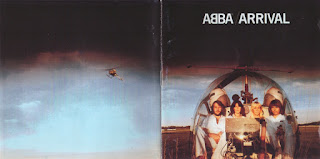Arrival is the fourth studio album by the Swedish pop group ABBA. It was originally released in Sweden on 11 October 1976 by Polar Records. Recording sessions began in August 1975 and continued until September 1976 at Metronome and Glen studios in Stockholm, Sweden. It became one of ABBA's most successful albums to date, producing three of their biggest hits: "Dancing Queen", "Money, Money, Money" and "Knowing Me, Knowing You". Upon its original 1976 release, "Fernando", released as a single earlier the same year, did not appear on Arrival, but it was included on the Australian and New Zealand versions. Arrival was the best-selling album of 1977 in the United Kingdom and was certified gold by the Recording Industry Association of America.
The album was first released on Compact disc in 1984 and then re-issued in digitally remastered form a total of four times; first in 1997, then in 2001, 2005 as part of The Complete Studio Recordings box set, and again in 2006 (as a special Deluxe Edition).
By the time ABBA began working on their fourth album in August 1975, they had achieved a modest level of success around the world. It was with Arrival however, that they would achieve global superstardom. The first song to enter the studio was a track called "Boogaloo" on 4 August. Taking inspiration from the current disco sound (and in particular George McCrae's "Rock Your Baby"), the backing track was laid down. The group knew that they had something big on their hands, as member Agnetha Faltskog remarked: "We knew immediately it was going to be massive". With re-written lyrics, the song became known as "Dancing Queen", and would go on to be ABBA's biggest ever hit. Work on the song continued intermittently until December 1975 as the group's activities were increasing in the latter half of the year as they saw a sudden surge in popularity in the United Kingdom and Australia. During this time they also recorded a song (in Swedish) for member Anni-Frid Lyngstad's solo album, "Fernando". In March 1976, with "Fernando" re-written with English lyrics, it was released as an ABBA single, becoming the group's biggest hit to date - hitting No.1 in many countries, including a 14-week stay at No.1 in Australia. Also around this time their Greatest Hits album was selling in huge numbers, becoming the biggest-selling album of the year in the UK. In the midst of this success, the group finally found time to return to the studio in late March. The next song they began working on was "Knowing Me, Knowing You", which was to become yet another major hit worldwide. Member Benny Andersson has said that it is "one of our five best recordings".
By the end of April two other songs had been laid down: "That's Me" and "Why Did It Have to Be Me". The latter was reworked into "Happy Hawaii" before ultimately arriving back at its original title with completely different lyrics and member Bjorn Ulvaeus on lead vocals as opposed to Faltskog and Lyngstad ("Happy Hawaii" would later be released as a B-side). A similar situation occurred with the next recording when a song entitled "Money, Money, Money" became "Gypsy Girl" and then back to its original title. "Money, Money, Money" would also be released as a single and become a major hit some months after the album's eventual release.
In June 1976, a TV special dedicated to the group (entitled ABBA-dabba-dooo!!) was filmed. Around the same time they recorded a song called "When I Kissed the Teacher", which would become the opening track on their new album. Late July saw the next two tracks, "Tiger" and "Dum Dum Diddle" recorded. Considered by biographer Carl Magnus Palm as the "complete antithesis" of each other, the former being a hard rocker against the pure pop of the latter, both Lyngstad and Ulvaeus have expressed dissatisfaction with "Dum Dum Diddle", with Ulvaeus admitting that it was a nonsense lyric he'd come up with in desperation. The next song to be recorded was "My Love My Life". Originally titled "Monsieur Monsieur" and more upbeat, the song soon became a lush ballad with backing harmonies inspired by 10cc's hit "I'm Not In Love".
The final track to be recorded was an instrumental piece entitled "Ode to Dalecarlia". Featuring Andersson prominently on keyboards, the track was renamed "Arrival" - a word that had already been decided as the title of their new album. By September 1976 work on the album was finished just as "Dancing Queen" was topping the charts all over the world. The album cover shots were taken of the group posing in and out of a Bell 47 helicopter at the Barkarby airfield, northwest of Stockholm. The now-renowned "mirrored-B" copyrighted ABBA logo, designed by Rune Söderqvist in 1976 — and said to have been inspired by Benny — was also premiered on the album cover. Arrival was released on 11 October 1976.
Track listing
All tracks written by Benny Andersson and Björn Ulvaeus except where noted.
Side one
- When I Kissed the Teacher" 3:00
- "Dancing Queen" Andersson/Stig Anderson/Ulvaeus 3:50
- "My Love, My Life" Andersson/Anderson/Ulvaeus 3:52
- "Dum Dum Diddle" 2:50
- "Knowing Me, Knowing You" Andersson/Anderson/Ulvaeus 4:02
Side two
- "Money, Money, Money" 3:05
- "That's Me" Andersson/Anderson/Ulvaeus 3:15
- "Why Did It Have to Be Me?" Andersson/Anderson/Ulvaeus 3:20
- "Tiger" 2:55
- "Arrival" 3:00
Total length: 33:09





























No hay comentarios.:
Publicar un comentario